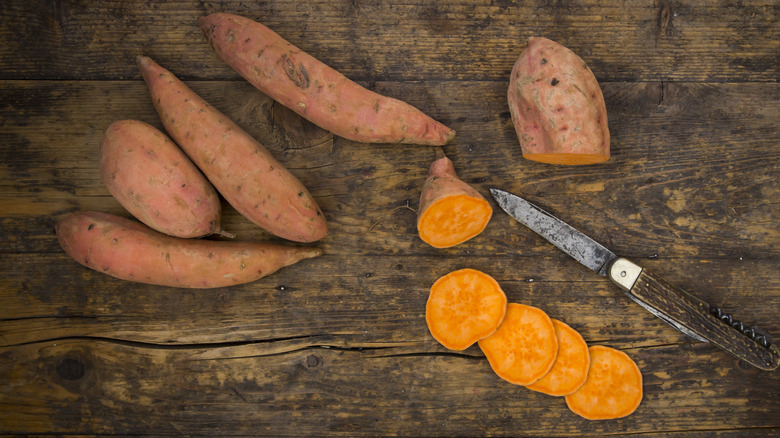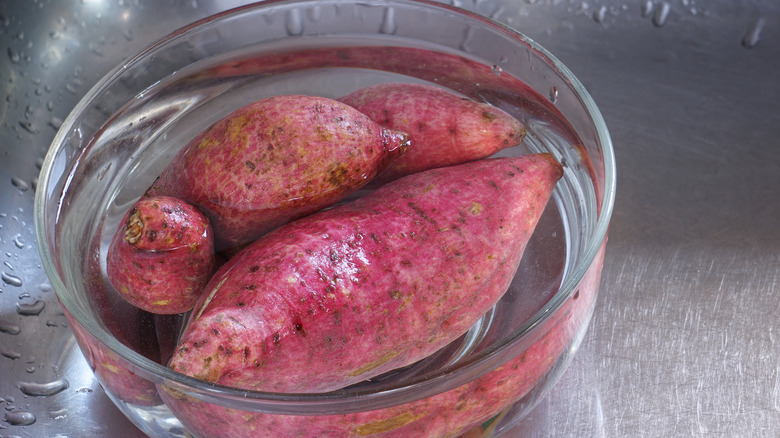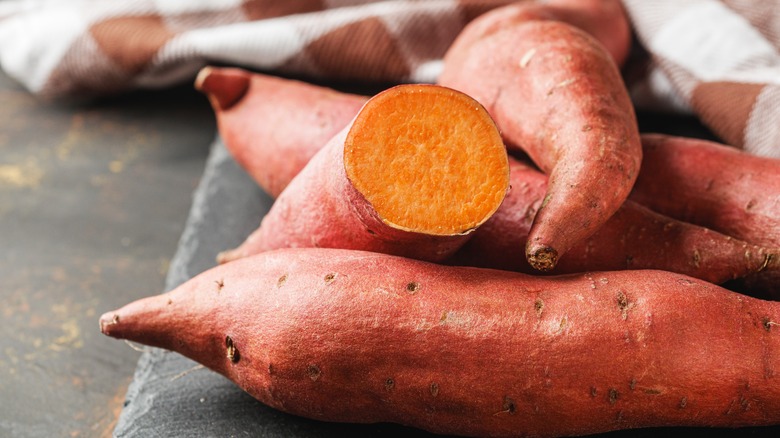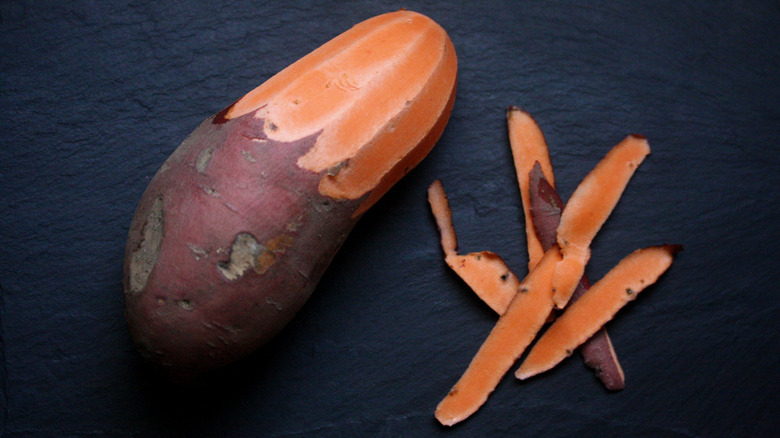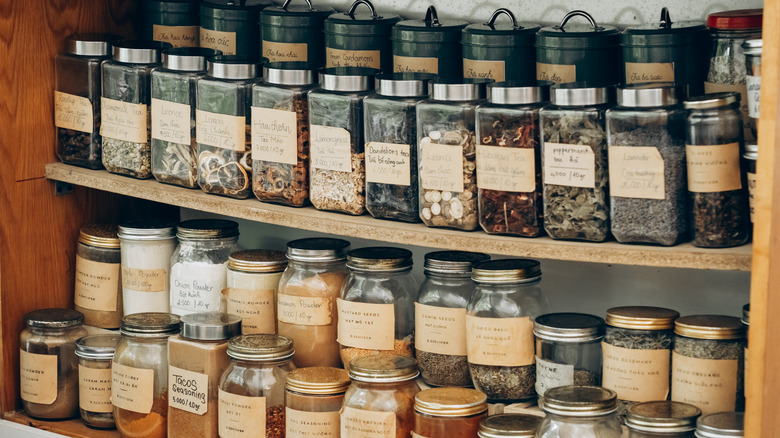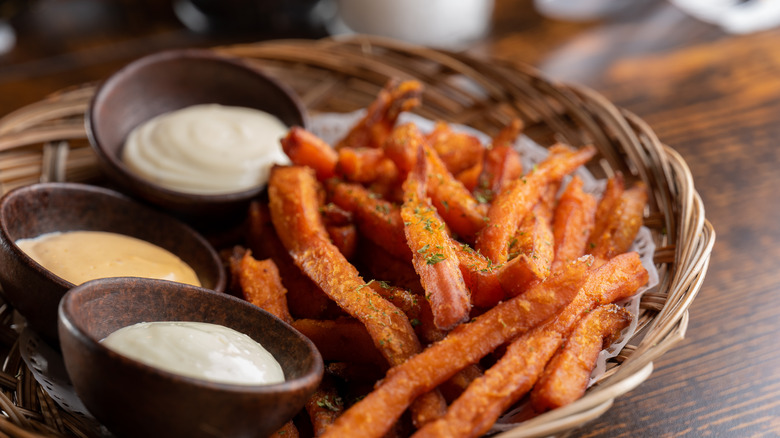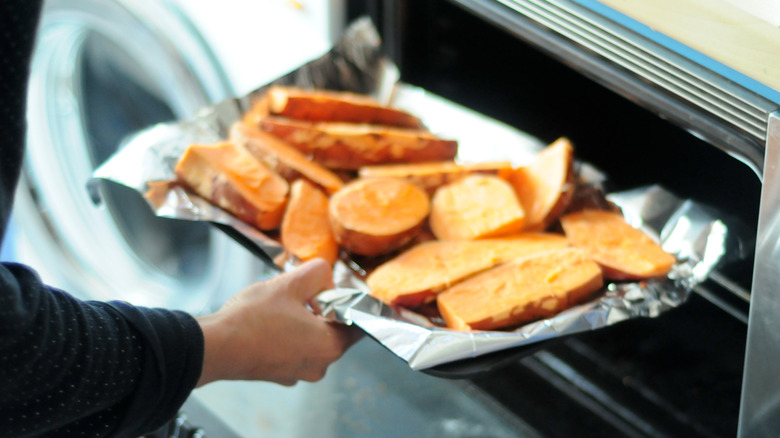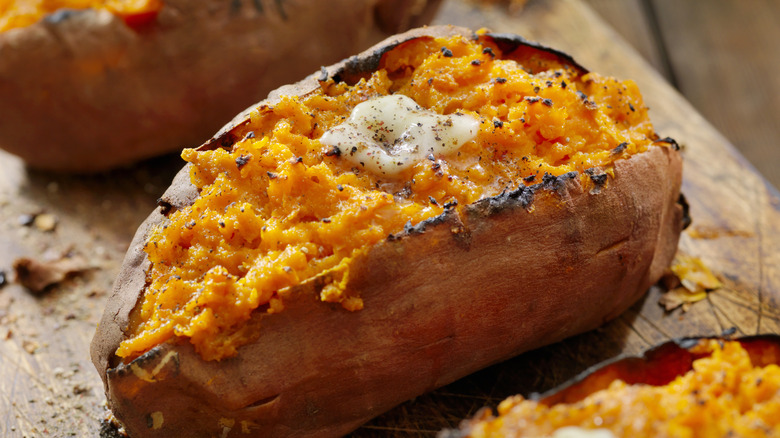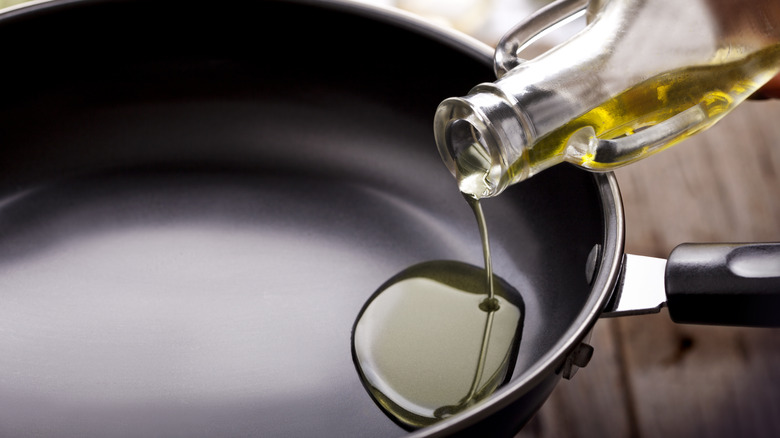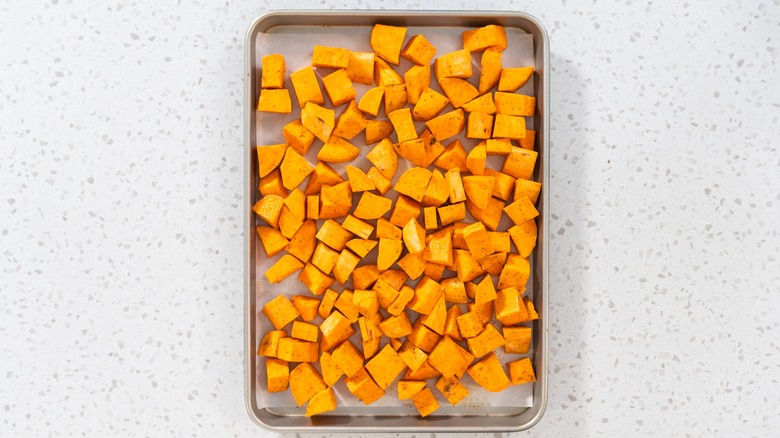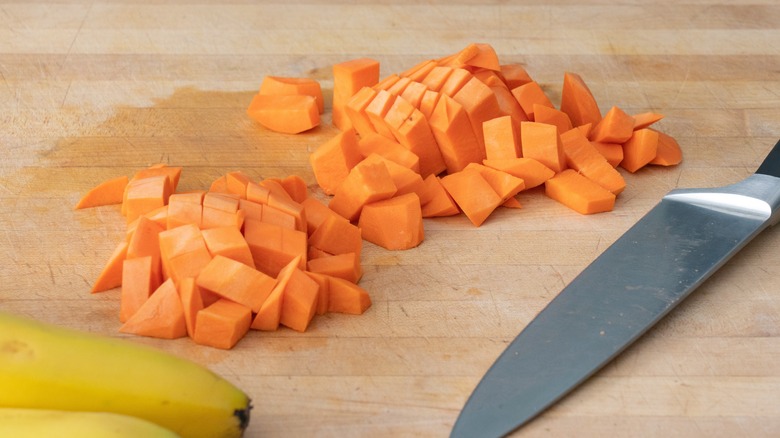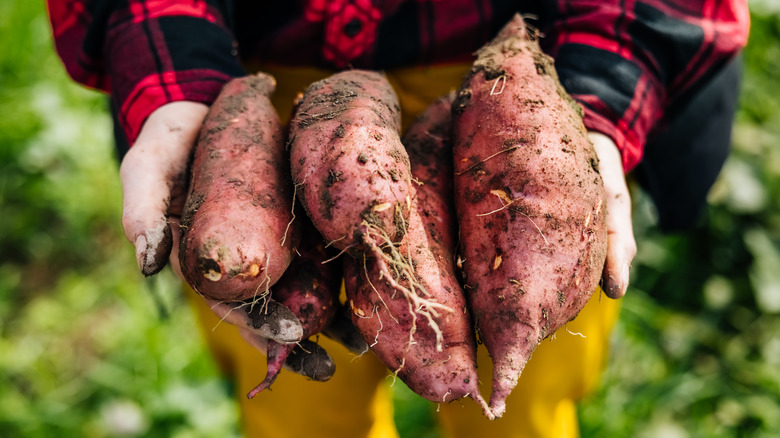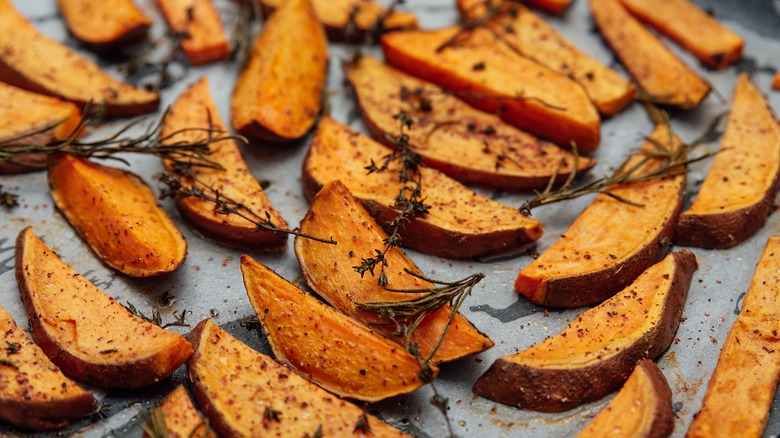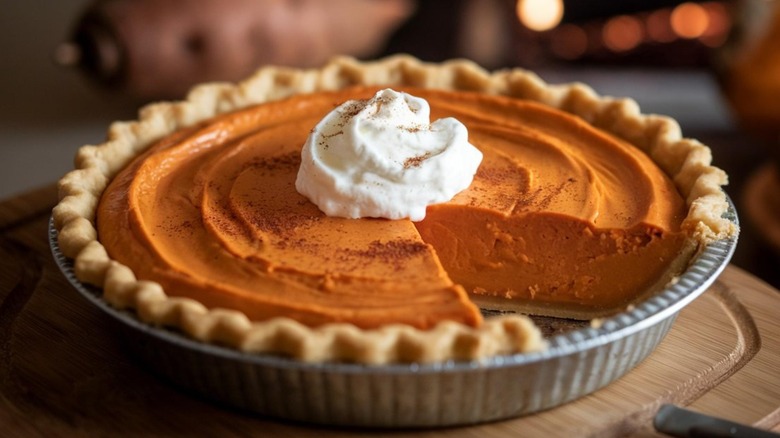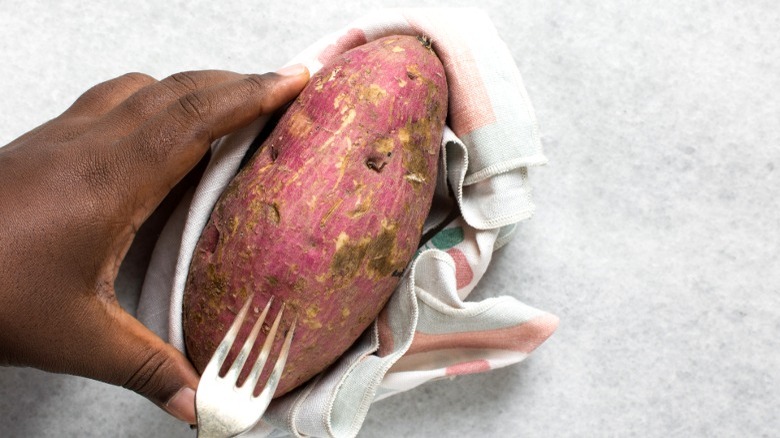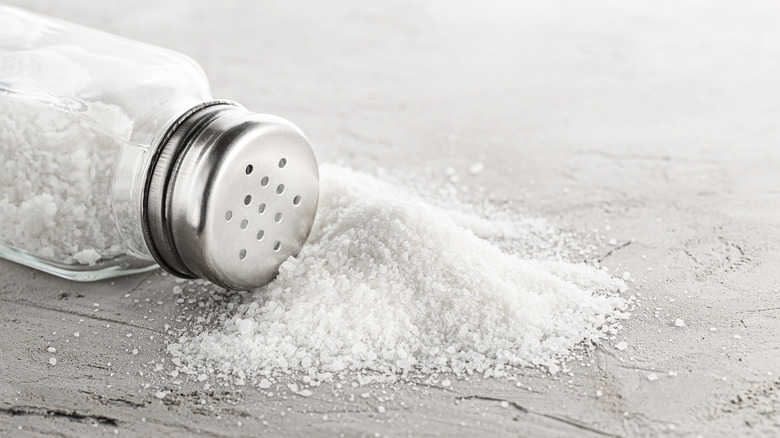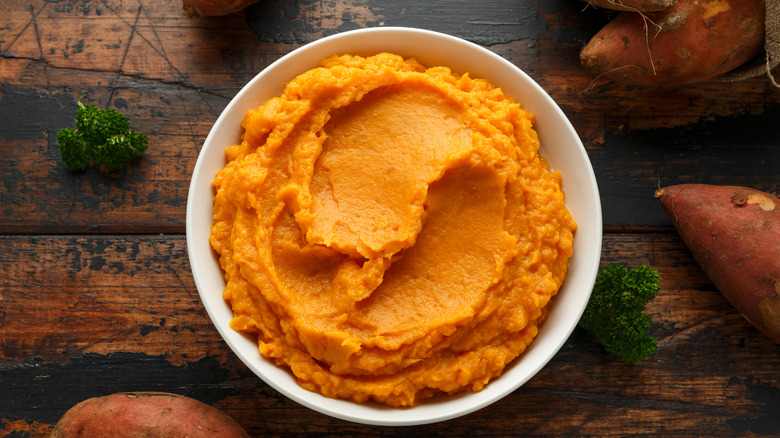16 Mistakes Everyone Makes When Cooking Sweet Potatoes
Cooking sweet potatoes is a fairly simple task, yet it's surprisingly easy to make small missteps that affect how they turn out. "I've seen some common pitfalls in kitchens over the years that can really impact the flavor and texture of this beautiful vegetable," notes Chef Brenton Banner, founder and head chef at Blossom Steakhouse. Not to mention, sweet potatoes are full of nutrients, but if they aren't treated just right, they can lose some of those healthy properties.
The good news is, there are some easy ways to avoid minor mistakes that can diminish a perfectly good sweet potato dish. According to Hailee Guillory, the culinary mind behind the recipe blog Old Fashioned Cravings, "Little tricks have made a huge difference in my kitchen." Whether you're a fan of roasted wedges, creamy mashed sides, or including them in your baked goods, these tips will help you avoid common errors so that you get the most out of your sweet potato recipes every time you cook with them.
Cooking without a pre-soak
Soaking your sweet potatoes beforehand helps reduce their cooking time and keeps them flavorful and perfectly soft. "I used to skip soaking sweet potatoes, thinking it didn't matter, but a quick soak before cooking reduces cooking time and keeps them tender. This is especially helpful when roasting or baking," shares Stephanie Edenburgh, seasoned home cook and founder of the Bizzie Mommy blog.
In case you're wondering about the science behind the soak, it helps break down the natural starches in the sweet potatoes, which will allow them to cook more evenly and achieve a nice, creamy texture without going mushy. This is especially useful if you're working with larger pieces or leaving the whole potato intact, as it will usually take ages to soften them. Even a 20-minute soak in cool water can have a significant impact on the cooking time. For those in a hurry, skipping the soak might be tempting, but this quick prep trick helps ensure each bite is tender and well-cooked in less time.
Discarding the skin
Sweet potato skins are packed with nutrients that will end up going to waste if they're peeled off and discarded. "The skin contains fiber and nutrients, so don't peel it off! Simply scrub them clean and roast them with the skin on for added nutrition and flavor," advises Sarah Bond, nutritionist, food scientist, and recipe developer at Live Eat Learn. Specifically, sweet potatoes contain "over 100% of the daily value of vitamin A," notes Sarah Herrington, nutritionist at Brio Medical. "Many people simply eat the insides and miss out on a lot of nutritional value." Aside from vitamin A, they also are high in fiber and antioxidants like beta-carotene.
Keeping the skin on can be a tasty choice as well. When you roast or fry them, it can really give your sweet potatoes a pleasant texture. Before you reach for the peeler, consider the added health and flavor benefits of leaving the skin on.
Peeling too early
If you are set on removing the nutritious sweet potato skin — not everyone likes the texture, after all — it's not the best idea to peel them too far in advance of cooking them. "I see people peel sweet potatoes well before they start cooking. Sweet potatoes oxidize fast, turning brown and losing flavor. I recommend peeling them just before cooking or storing them in water if you prep early," says Chef Brenton Banner.
Stephanie Edenburgh agrees on this point. "I know how tempting it is to prep ahead, but peeling sweet potatoes too early exposes them to air, which can make them dry and even cause discoloration," she explains. "I recommend peeling them just before cooking." Instead of sacrificing taste and freshness, focus on prepping other ingredients first. By waiting to peel, you avoid unnecessary flavor loss and ensure your sweet potatoes are as vibrant and tasty as possible when they hit the pan or oven.
Underseasoning or using the wrong seasonings
Sweet potatoes are naturally sweet, which can make them a bit tricky to season just right, but don't be fooled by their inherent flavor — skipping seasoning altogether would mean missing out on their full potential. "Sweet potatoes can handle more seasoning than you might think. A sprinkle of salt enhances their natural sweetness, and spices like cinnamon, cumin, or smoked paprika add depth," says Sarah Bond.
Hailee Guillory points out that experimenting with spices opens up different ways to enjoy the versatile flavor of sweet potatoes. "Cinnamon is amazing for a family-friendly version, while paprika and cumin add a savory twist that makes them stand out," she shares. For even more variety, try adding nutmeg or allspice for a warm, autumnal feel, or chipotle powder for a smoky heat. Seasoning them with ginger, curry powder, and garlic can also complement the earthy notes, making sweet potatoes shine in new and unexpected ways.
Relying on a single cooking method
Baking is one of the most popular ways to prepare sweet potatoes, but it's not the only option — and trying various cooking methods can open up new flavors and textures. "Many people stick to baking, but sweet potatoes shine in other methods too, like grilling, steaming, or even microwaving when you're short on time," says Sarah Bond.
Grilling sweet potatoes, for instance, can add a smoky flavor that contrasts beautifully with their natural sweetness. Steaming preserves more of their moisture for a soft, melt-in-your-mouth experience. Microwaving, on the other hand, can be a super convenient way to enjoy sweet potatoes on busy days without compromising much on taste. Frying them up as sweet potato fries is another fantastic option, offering a crispy, caramelized exterior that highlights their sugars. These different cooking techniques bring out unique textures and flavors in this versatile starch. Don't be afraid to step outside the baking box — sweet potatoes have endless possibilities for delicious preparations.
Cooking at the wrong temperature
The baking temperature can have a significant impact on your sweet potato dish. For the best results, "sweet potatoes need high heat to caramelize properly. I think 400 F to 425 F is ideal for roasting to get that delicious, crispy outside and soft inside. I used to roast at 350 F and missed out on that amazing texture and flavor," advises Stephanie Edenburgh. Chef Brenton Banner concurs. "Low heat makes sweet potatoes gummy instead of tender. I always bake them at 400 F to 425 F, which caramelizes their sugars beautifully and brings out their natural sweetness," Banner says.
On the other hand, Hailee Guillory has had success with slightly lower heat for a longer time, which she says brings out the best texture without charring. "I roast them at 375 F for a little longer; they get soft on the inside and caramelize perfectly on the edges. Low and slow is the trick!" she says. All in all, the ideal range between 375 F and 425 F seems to be your best bet, ensuring the potatoes leave the oven cooked just right.
Overcooking
Cooking sweet potatoes for too long can easily result in overly soft results that mask their natural flavor and can even make them taste a bit too sweet. "Overcooking is a typical problem that many people face, resulting in unpleasant mush," confirms avid home cook Rory Donadio. "To avoid this, I check for doneness by inserting a fork; if it glides in easily, they are ready."
Timing is key, which varies depending on your cooking method. For baking or roasting, check them about halfway through the recommended time and again closer to the end, so you don't miss the moment they've reached the right amount of tenderness. If you're boiling, keep an eye out after the first 15 minutes, especially if you've cut them into smaller pieces — they cook faster than larger chunks or whole. No matter how you're preparing your sweet potatoes, the key is to pay attention so that you can enjoy them in their ideal form: soft, but not too soft that they turn into mush.
Skimping on oil
Finding the sweet spot with oil is crucial when preparing sweet potatoes. Too little, and you'll miss out on that tasty caramelization that makes them irresistible. Too much, and you'll end up with a greasy mess that is not pleasant to eat. Getting it just right unlocks their full potential, all the while ensuring they don't stick to your pan or baking sheet. Stephanie Edenburgh learned this through experience: "Sweet potatoes need a bit of oil to bring out their natural sweetness and prevent them from sticking. I used to go too light on oil, but now I toss them generously, add spices like cinnamon or cumin, and it makes a world of difference."
However, Chef Brenton Banner offers an important caveat: "Sweet potatoes don't need a lot of oil because they're already rich in texture. I use just enough oil to coat them, avoiding that heavy, greasy taste." The key is finding the right balance — enough to promote browning, but not so much that they're drowning.
Overcrowding the pan or baking sheet
We've all been there, trying to squeeze one more potato onto an already-packed baking sheet or frying pan. However, this common mistake can turn what should be crispy, caramelized pieces of sweet potato into a disappointing eating experience. Hailee Guillory is no stranger to this scenario: "Back in the day, I'd pile as many pieces as I could onto a single baking sheet to avoid using two trays. But crowded sweet potatoes just steam instead of roasting, which makes them soft and mushy instead of crispy. I've learned to spread them out with a little space between each piece, and if I need to, I use two trays. It's worth the little extra cleanup."
A good rule of thumb is to leave about half an inch between pieces on a baking sheet, especially if texture is important to you in your sweet potatoes. In a pan, simply make sure they're in a single layer and not piled in there. That way, you'll end up with sweet potatoes that have the best of both worlds: crispy edges and tender centers.
Cutting them unevenly
The way you slice and dice your sweet potatoes might seem like a minor detail, but it can really impact how they turn out. In the hustle of preparing a meal, it can be all too easy to rush through the chopping process. Taking a few extra moments to ensure uniform pieces pays off in the end. "I learned the hard way that uneven pieces cook unevenly, which means half are soft and the other half are tough," Hailee Guillory admits.
Sarah Bond wholeheartedly agrees with this tip."Uneven chunks can lead to inconsistent cooking, with some pieces mushy and others undercooked. Aim for uniform slices for better results." Whether you're making fries, roasted chunks, or medallions, consistent sizing ensures every piece reaches the perfect doneness simultaneously.
Evenly-sized sweet potatoes cook more uniformly and create a more appealing presentation on the plate. This attention to detail will make the meal feel like more than just a meal, but also a culinary accomplishment. Next time you're preparing sweet potatoes, remember that a little extra care in cutting can make a notable difference in texture, taste, and look.
Neglecting to wash them before cooking
Even if peeling is part of your prep plan, washing sweet potatoes is a necessary first step that too many home cooks skip. As they are root vegetables, "Sweet potatoes are grown below ground and need to be thoroughly scrubbed prior to cooking," advises Sarah Herrington. A thorough wash means you're starting with the cleanest possible ingredient, as you get rid of dirt, pesticides, and whatever might have been crawling around down there. Whether you're keeping the skins on or not, washing your sweet potatoes is a must.
Washing them isn't just for cleanliness and food safety, either. It can also remove the possibility of foreign elements in your meal. "The skins can hold on to dirt, which can make your dish gritty. I now give them a solid wash — even if I plan to peel them — so no one gets a sandy bite," mentions Hailee Guillory. Ultimately, a simple wash not only improves the overall quality of your dish but also reflects a commitment to good cooking practices.
Ignoring rest time after roasting
The moments right after your sweet potatoes come out of the oven are more important than you might think. While it's tempting to dive right in, a little patience goes a long way in achieving the perfect texture. Just like with meat, letting your roasted sweet potatoes rest allows the internal temperature to stabilize and the moisture to redistribute evenly throughout.
Chef Brenton Banner provides a clear explanation for why this step matters: "Cutting them too soon lets steam escape, leading to dry sweet potatoes. I give them a few minutes to rest, letting the juices settle for the best texture." How long you let them rest may depend on the size of your sweet potato pieces. Smaller pieces need less time than a baked whole sweet potato, for example. During this time, you can finish preparing other components of your meal while your sweet potatoes reach their peak texture and flavor potential.
Not cooling before adding them to desserts
When incorporating sweet potatoes into baked goods, temperature matters. Adding hot sweet potatoes to your dessert batter might seem like a time-saver, but it can seriously compromise the texture of your final product. This is important when making dishes like sweet potato pie, muffins, quick breads, or any other dessert recipe.
"When I first tried adding sweet potatoes to desserts like muffins or pie," shares Hailee Guillory, "I'd throw hot sweet potatoes straight into the batter, which would make everything weirdly gummy or dense. Now, I bake or steam them, let them cool completely, and then mash them. This keeps baked goods light and fluffy without any gummy texture."
This simple cooling step allows the starches in sweet potatoes to set properly, creating a smoother blend when mixed with other ingredients. Additionally, using cooled sweet potatoes helps maintain the integrity of other delicate components, like eggs and flour, ensuring they don't start to cook prematurely. Temperature control plays a role in flavor development, as cooled sweet potatoes offer a richer, more concentrated sweetness, improving the overall taste of your desserts. While it may take a bit of extra time, allowing your sweet potatoes to cool before mixing them in will lead to far superior dessert results.
Baking without poking holes first
Neglecting to poke holes in your sweet potatoes before baking can lead to unexpected and messy consequences. Chef Brenton Banner highlights the importance of this simple step: "Many people skip poking their sweet potatoes before baking, which can result in bursting and uneven cooking. I always pierce them several times with a fork to ensure they cook evenly without any explosive surprises."
Hailee Guillory learned this lesson the hard way. "One time, I baked whole sweet potatoes without poking holes, thinking it wouldn't be an issue. Let's just say I spent half an hour scrubbing my oven afterward!" By poking a few holes with a fork, you allow steam to escape, preventing the chance of explosions like this. It's a minor effort that makes a major difference in your cooking results. "It's essential to poke holes with a knife or fork. This allows heat to escape," adds Sarah Herrington, to explain the science behind it. In short, if you want to avoid a sweet potato disaster in your oven or microwave, don't forget the holes.
Forgetting to add salt
It may seem counterintuitive, but adding a pinch of salt to sweet potatoes can make a surprising difference, elevating their inherent sweetness and balancing out the flavors. "Many skip salt, thinking sweet potatoes don't need it. But a pinch of salt enhances their flavor profile. I season them lightly with sea salt, even when using them in sweeter recipes," advises Chef Brenton Banner. This straightforward tip can transform the taste experience, bringing out the subtler notes that might otherwise be overshadowed by sweet potatoes' natural sugars.
This is true no matter how you're cooking them: roasting, mashing, frying or even incorporating sweet potatoes into a dessert. Adding a little salt can make a noticeable impact. For example, when roasting, a sprinkle of salt adds depth and complements the caramelization that occurs in the oven. In baked goods, just a touch of salt deepens the flavor without overpowering the sweetness, helping the earthy, warm qualities of sweet potatoes come through fully.
Boiling instead of steaming
Boiling is a common cooking method for sweet potatoes, but Chef Breton Banner advises against it when making mashed sweet potatoes. "For mash, I think steaming is much better than boiling, as boiling can make sweet potatoes watery and bland. Steaming keeps the flavor concentrated, resulting in a creamier, richer mash," he states with authority.
What's more, the differences go beyond taste and texture. Boiling also affects the nutritional profile of sweet potatoes. "Boiling vegetables causes nutrients to seep into water that is then discarded," notes Sarah Herrington. That is especially true for water-soluble nutrients like vitamin C and potassium. Steaming, however, better preserves these nutrients, making it a healthier option for those looking to maximize the benefits of this healthy starch. For a truly flavorful and nutrient-packed sweet potato mash (or any other sweet potato dish, while we're at it), steaming is clearly the optimal route.
